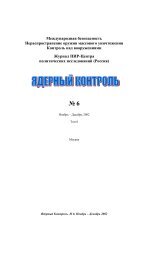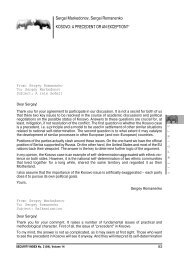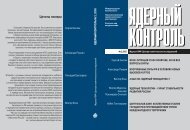Ekaterina Shadrina THE GREAT CASPIAN CAVIAR GAME
Ekaterina Shadrina THE GREAT CASPIAN CAVIAR GAME
Ekaterina Shadrina THE GREAT CASPIAN CAVIAR GAME
Create successful ePaper yourself
Turn your PDF publications into a flip-book with our unique Google optimized e-Paper software.
and just 25 tons exported, according to official reports. In 2000 the industrial fishing of sturgeon<br />
was halted, and only accidental catches were permitted when fishing for other species of<br />
river fish; then, in 2005, accidental catches were also forbidden. Currently, sturgeons are<br />
caught for reproductive and research purposes.<br />
Despite official announcements and directives, Russian stores have continued to offer various<br />
sturgeon products without any interruption. According to Robert Moiseyev, director of the<br />
Pacific Institute of Geography at the Russian Far East Academy of Sciences (Petropavlovsk-<br />
Kamchatsky), the trade in caviar and fish has grown into a multi-level, underground system that<br />
spans several economic sectors:<br />
“…there are those that catch the fish, a second group that prepares them, while others are in<br />
charge of refrigerator storage; a fourth group takes it to the aircraft, where a fifth group flies the<br />
plane, then a sixth group accepts the goods outside Moscow, where the main fish processing<br />
plants are. There are people who maintain these plants, people who sell the product, and<br />
someone is giving them all ‘protection.’” 31<br />
Russia, according to modest estimates, loses up to U.S. $400 million each year to poaching<br />
while even Turkey, which has no stocks of sturgeon, has overtaken Russia in the export<br />
of this delicacy. 32 The Russian Interior Ministry estimates that black market income from the<br />
illegal production of caviar and sturgeon fish is comparable to the profit from the illegal<br />
drug trade. 33<br />
Poaching exists in all three federal subjects of the Russian Federation with access to the<br />
Caspian: Dagestan, Kalmykia, and Astrakhan oblast. The fishing in the first two is conducted at<br />
sea, with poachers working not only along their own coastline, but also penetrating neighboring<br />
waters, including those of Kazakhstan, traveling far to the east of their own shores. Special<br />
high-speed vessels, often so-called “cigarette boats,” fitted with imported outboard motors<br />
and satellite navigation systems make it possible in good weather to reach fishing areas within<br />
a matter of hours. In Astrakhan oblast, poachers work in the same way both on rivers, usually<br />
using small boats, and at sea, deploying the same methods as poachers from Dagestan and<br />
Kalmykia. It is almost impossible to say which of the above areas deserves the gold medal for<br />
illegal poaching, although an analysis of news reports in the regional and federal media indicates<br />
that law enforcement agencies most frequently detain citizens of Dagestan and<br />
Kalmykia.<br />
The main problem in the Russian approach to preservation of sturgeon and making money<br />
from the export of sturgeon is, without a doubt, state bureaucracy, corruption, and the apparent<br />
low priority of this issue in federal politics. Despite numerous declarations by the authorities<br />
concerning the need for urgent reforms in the fishing industry as a whole and sturgeon<br />
fishing in particular, very little has actually been done.<br />
Nevertheless, some of the prerequisites for improving the situation have been created in the<br />
last two years.<br />
First, the CITES Management Authority of the Russian Federation for Sturgeon was founded in<br />
September 2005; this agency is responsible for observing CITES procedures and is currently<br />
under the jurisdiction of the Ministry for Agriculture and Rosselkhoznadzor, the Russian<br />
Agriculture Inspection Agency. It is hard to believe, but due to bureaucratic delays in the creation<br />
of this structure Russia was unable to export black caviar for several years, thus losing a<br />
major income stream. 34 According to Lidiya Vasiliyeva, the director of the BIOS Research and<br />
Production Center for Sturgeon Breeding, the reason for this is strictly bureaucratic in nature:<br />
“In Bulgaria, for example, where there already is a CITES agency, it takes about half a day to<br />
obtain a license and export caviar across the border. But I need to get through 12 agencies,<br />
which takes two full months. Although we have a breeder stock, there is nothing we can do. As<br />
a result, Russia is losing one of its national treasures.” 35<br />
SECURITY INDEX No. 1 (81), Volume 13<br />
63<br />
A N A L Y S E S








